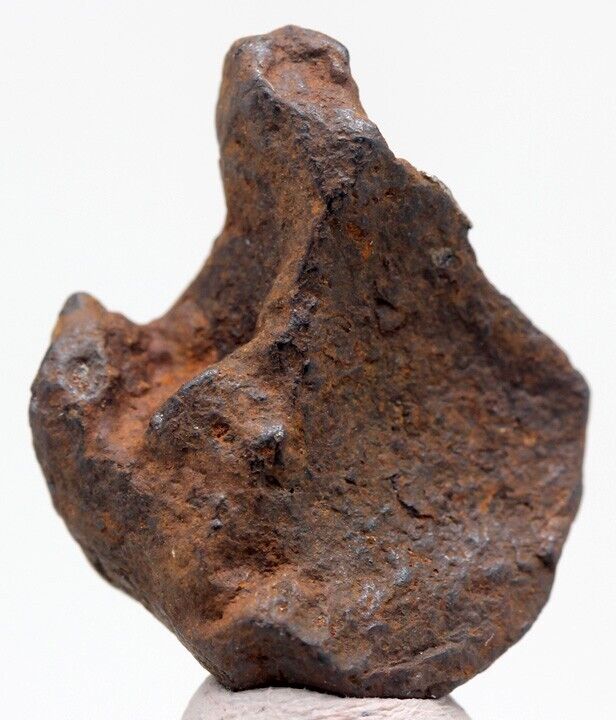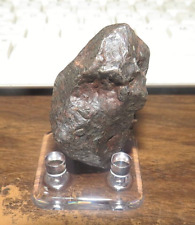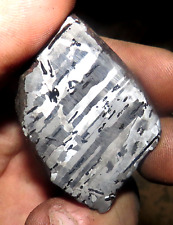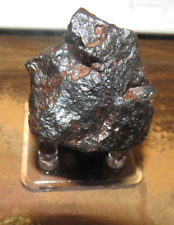CANYON DIABLO Meteor Crater Iron Meteorite WHOLE Specimen WINSLOW ARIZONA For Sale

When you click on links to various merchants on this site and make a purchase, this can result in this site earning a commission. Affiliate programs and affiliations include, but are not limited to, the eBay Partner Network.
CANYON DIABLO Meteor Crater Iron Meteorite WHOLE Specimen WINSLOW ARIZONA:
$49.95
This specimen weighs 6.36 grams. It measures 24 mm x 20 mm x 8 mm.I offer a shipping discount for customers who combine their payments for multiple purchases into one payment!The discount is regular shipping price for the first item and just 50 cents for each additional item!
To be sure you get your shipping discount just make sure all the items you want to purchase are in your cart.
sales you win are added to your cart automatically.
For any "buy it now" items or second chance offers, be sure to click the "add to cart" button, NOT the "buy it now" button.
Once all of your items are in your cart just pay for them from your cart and the combined shipping discount should be applied automatically.I offer a money back guarantee on every item I sell.
If you are not 100% happy with your purchase just send me a message to let me know
and I will buy back the item for your full purchase price.Hi there, I am selling this amazing Canyon Diablo Iron Meteorite specimen! This is a piece of the meteorite that created Meteor Crater in the desert plains of Northern Arizona! Meteor Crater, aka Barringer Crater, was formed approximately 50,000 years ago when an iron meteorite measuring 160 feet across and weighing hundreds of thousands of tons slammed into the ground at 30,000 miles per hour. The energy of the impact was equivalent to 10 megatons of TNT (that's 10 million tons!)! The impact created a gaping crater three quarters of a mile wide and 560 feet deep. Most of the solid iron impactor was vaporized in the blast but hundreds of thousands of small fragments survived and were strewn for miles in every direction. Since this was one of the earliest identified meteor impacts people have been collecting specimens of the meteor for decades. This long running demand combined with the fact that much of the land around the crater is privately owned means there are not many new specimens of this meteorite coming to the market anymore. Don't let this one pass you by. If you have any questions, do not hesitate to ask me. Thanks so much for shopping at my store and have a great day!
If you purchase from me you should know that the authenticity of this meteorite is guaranteed!
I am a member of the IMCA or the International Meteorite Collector's Association. This is an organization that is a check and balance of those who collect, trade and sell meteorites. You can only join this organization by having the utmost integrity. You must to have two references from existing members to get in and a good reputation. Members of this organization maintain a high standard by monitoring each others' activities for accuracy and honesty. It is every IMCA member's responsibility and pleasure to offer help and assistance to fellow members in order to ensure specimens are genuine. It is not wise to purchase meteorites on or other sources from those who are not IMCA members. This is a very tight-knit community made up of meteorite hunters, dealers, collectors, and scientists who look out for each other to make sure that the meteorites offered to the public are authentic and genuine. I encourage you to visit the IMCA website and get more information on what being a member means, and how your purchases from its members are guaranteed.
IMCA Member #7446
Below is some information about this meteorite:Meteor CraterFrom Wikipedia, the free encyclopediaJump to navigationJump to searchFor meteorite-created craters in general, see Impact crater."Barringer Crater" redirects here. For the crater on the Moon, see Barringer (lunar crater).Meteor CraterBarringer CraterMeteor Crater - Arizona.jpgMeteor Crater, also known as Barringer CraterImpact crater/structureConfidence Confirmed[1]Diameter 0.737 miles (1.186 km)Depth 560 feet (170 m)Rise 148 feet (45 m)Impactor diameter 160 feet (50 m)Age 50,000 yearsExposed YesDrilled YesBolide type Iron meteoriteLocationLocation Coconino CountyCoordinates 35°01′41″N 111°01′24″WCoordinates: 35°01′41″N 111°01′24″WCountry United StatesState ArizonaMeteor Crater is located in ArizonaMeteor CraterMeteor CraterLocation of Meteor Crater in ArizonaAccess Interstate 40U.S. National Natural LandmarkDesignated November 1967Meteor Crater, or Barringer Crater,[2][3][4][5][6] is a meteorite impact crater about 37 mi (60 km) east of Flagstaff and 18 mi (29 km) west of Winslow in the desert of northern Arizona, United States. The site had several earlier names, and fragments of the meteorite are officially called the Canyon Diablo Meteorite, after the adjacent Cañon Diablo.[7] Because the United States Board on Geographic Names recognizes names of natural features derived from the nearest post office, the feature acquired the name of "Meteor Crater" from the nearby post office named Meteor.[8][better source needed]
Meteor Crater lies at an elevation of 5,640 ft (1,719 m) above sea level.[9] It is about 3,900 ft (1,200 m) in diameter, some 560 ft (170 m) deep, and is surrounded by a rim that rises 148 ft (45 m) above the surrounding plains. The center of the crater is filled with 690–790 ft (210–240 m) of rubble lying above crater bedrock.[1] One of the interesting features of the crater is its squared-off outline, believed to be caused by existing regional jointing (cracks) in the strata at the impact site.[10]
Despite historic attempts to make the crater a public landmark,[11] the crater remains privately owned by the Barringer family to the present day through their Barringer Crater Company, which proclaims it to be the "best-preserved meteorite crater on Earth".[12][13] Since the crater is privately owned, it is not protected as a national monument, a status that would require federal ownership. It was designated a National Natural Landmark in November 1967.[14]Contents1 Formation2 Discovery and investigation2.1 Albert E. Foote2.2 Grove Karl Gilbert2.3 Daniel M. Barringer2.4 Harvey H. Nininger2.5 Eugene M. Shoemaker3 Geology4 Recent history5 Tourist attraction6 See also7 References8 External linksFormation
Comparison of approximate sizes of notable impactors with the Hoba meteorite, a Boeing 747 and a New Routemaster busThe crater was created about 50,000 years ago during the Pleistocene epoch, when the local climate on the Colorado Plateau was much cooler and damper.[15][16] The area was an open grassland dotted with woodlands inhabited by mammoths and giant ground sloths.[17][18]
The object that excavated the crater was a nickel-iron meteorite about 160 ft (50 m) across. The speed of the impact has been a subject of some debate. Modeling initially suggested that the meteorite struck at up to 45,000 mph (20 km/s), but more recent research suggests the impact was substantially slower, at 29,000 mph (12.8 km/s). About half of the impactor's bulk is believed to have been vaporized during its descent through the atmosphere.[19] Impact energy has been estimated at about 10 megatons TNTe. The meteorite was mostly vaporized upon impact, leaving few remains in the crater.[20]
Since the crater's formation, the rim is thought to have lost 50–65 ft (15–20 m) of height at the rim crest as a result of natural erosion. Similarly, the basin of the crater is thought to have roughly 100 ft (30 m) of additional postimpact sedimentation from lake sediments and alluvium.[21] Very few remaining craters are visible on Earth, since many have been erased by erosive geological processes. The relatively young age of Meteor Crater, paired with the dry Arizona climate, has allowed this crater to remain comparatively unchanged since its formation. The lack of erosion that preserved the crater's shape greatly accelerated its groundbreaking recognition as an impact crater from a natural celestial body.[22]
Discovery and investigation
The Holsinger meteorite, at roughly 0.8 m (2½ ft) across, is the largest discovered fragment of the meteorite that created Meteor Crater, and it is exhibited in the crater visitor center.The crater came to the attention of scientists after American settlers encountered it in the 19th century. The crater was given several early names, including "Coon Mountain", "Coon Butte", "Crater Mountain", "Meteor Mountain", and "Meteor Crater".[23][24][25] The Meteoritical Society refers to the crater as Barringer Meteorite Crater [26] because Daniel M. Barringer was one of the first people to suggest that it was produced by meteorite impact, and because the Barringer family filed mining claims on the crater and purchased the crater and its surroundings in the early 20th century.[27][28] Meteorites from the area were called Canyon Diablo meteorites, after Canyon Diablo, Arizona, which was the closest community to the crater in the late 19th century. The canyon also crosses the strewn field, where meteorites from the crater-forming event were found. The crater had initially been ascribed to the actions of a volcanic steam explosion, because the San Francisco volcanic field lies only about 40 mi (64 km) to the west.[29]
Albert E. FooteIn 1891, mineralogist Albert E. Foote presented the first scientific paper about the meteorites of Northern Arizona.[30] Several years earlier, Foote had received an iron rock for analysis from a railroad executive. Foote immediately recognized the rock as a meteorite and led an expedition to search and retrieve additional meteorite samples. The team collected samples ranging from small fragments to over 600 lb (270 kg). Foote identified several minerals in the meteorites, including diamond, albeit of little commercial value. His paper to the Association for the Advancement of Science provided the first geological description of the crater to a scientific community.[31]
Grove Karl GilbertIn November 1891, Grove Karl Gilbert, chief geologist for the U.S. Geological Survey, investigated the crater and concluded that it was the result of a volcanic steam explosion.[31] Gilbert had assumed that if it were an impact crater, then the volume of the crater, as well as meteoritic material, should exist in the rim. Gilbert also assumed a large portion of the meteorite should be buried in the crater and that this would generate a large magnetic anomaly. Gilbert's calculations showed that the volume of the crater and the debris on the rim were roughly equivalent, so that the mass of the hypothetical impactor was missing, nor were there any magnetic anomalies; he argued that the meteorite fragments found on the rim were coincidental. Gilbert publicized his conclusions in a series of lectures.[32] In 1892, however, Gilbert would be among the first to propose that the Moon's craters were caused by impact rather than volcanism.[33]
Daniel M. Barringer
Looking into the crater from the north rim: The rust-colored area on the far (south) rim is where the last drilling for the meteorite occurred, in 1929. This is where Daniel M. Barringer believed the bulk of the meteorite was buried. Rock around the south rim is lifted up.In 1903, mining engineer and businessman Daniel M. Barringer suggested that the crater had been produced by the impact of a large iron-metallic meteorite. Barringer's company, the Standard Iron Company, staked a mining claim to the land and received a land patent signed by Theodore Roosevelt for 640 acres (1 sq mi, 260 ha) around the center of the crater in 1903.[34][35][28] The claim was divided into four quadrants coming from the center clockwise from north-west named Venus, Mars, Jupiter, and Saturn. In 1906, Roosevelt authorized the establishment of a newly named Meteor, Arizona, post office (the closest post office before was 30 mi (48 km) away in Winslow, Arizona).[36] This new post office was located at Sunshine, a stop on the Atchison, Topeka and Santa Fe Railway, 6 mi north of the crater.[37]Close-up of old mine shaft at the bottom of the crater: The Barringer Crater Company has attached an astronaut cutout and flag to the fence (inset; see full-sized image).Standard Iron Company conducted research on the crater's origins between 1903 and 1905. It concluded that the crater had indeed been caused by an impact. Barringer and his partner, mathematician and physicist Benjamin Chew Tilghman, documented evidence for the impact theory in papers presented to the U.S. Geological Survey in 1906 and published in the Proceedings of the Academy of Natural Sciences in Philadelphia.[38]
Barringer's arguments were met with skepticism, as a reluctance existed at the time to consider the role of meteorites in terrestrial geology. He persisted and sought to bolster his theory by locating the remains of the meteorite. At the time of discovery, the surrounding plains were covered with about 30 tons of large, oxidized iron meteorite fragments. This led Barringer to believe that the bulk of the impactor could still be found under the crater floor. Impact physics was poorly understood at the time, and Barringer was unaware that most of the meteorite vaporized on impact. He spent 27 years trying to locate a large deposit of meteoric iron, and drilled to a depth of 1,375 ft (419 m), but no significant deposit was ever found.[39][self-published source?]
Barringer, who in 1894 was one of the investors who made US$15 million in the Commonwealth silver mine in Pearce, Cochise County, Arizona, had ambitious plans for the iron ore.[40] He estimated from the size of the crater that the meteorite had a mass of 100 million tons.[32] Iron ore of the type found at the crater was valued at the time at US$125/ton, so Barringer was searching for a lode he believed to be worth more than a billion 1903 dollars.[40] "By 1928, Barringer had sunk the majority of his fortune into the crater – $500,000, or roughly $7 million in [2017] dollars."[41]
In 1929, astronomer F.R. Moulton was employed by the Barringer Crater Company to investigate the physics of the impact event. Moulton concluded that the impactor likely weighed as little as 300,000 tonnes, and that the impact of such a body would have generated enough heat to vaporize the impactor instantly.[42][43][44] Daniel M. Barringer died just ten days after the publication of Moulton's second report.
By this time, "the great weight of scientific opinion had swung around to the accuracy of the impact hypothesis ... Apparently an idea, too radical and new for acceptance in 1905, no matter how logical, had gradually grown respectable during the intervening 20 years."[45]
Harvey H. Nininger
Fragment of the Cañon Diablo MeteoriteHarvey Harlow Nininger was an American meteoriticist and educator, and although he was self-taught, he revived interest in scientific study of meteorites in the 1930s, and assembled the largest personal collection of meteorites up to that time. While based in Denver, Colorado, Nininger published the first edition of a pamphlet titled "A Comet Strikes the Earth", which described how Meteor Crater formed when an asteroid impacted the Earth.[46] In 1942, Harvey Nininger moved his home and business from Denver to the Meteor Crater Observatory, located near the turn-off for Meteor Crater on Route 66.[47] He renamed the building the "American Meteorite Museum" and published a number of meteorite and Meteor Crater-related books from the location. He also conducted a wide range of research at the crater, discovering impactite, iron-nickel spherules related to the impact and vaporization of the asteroid, and the presence of many features still unique to the crater, such as half-melted slugs of meteoric iron mixed with melted target rock. Nininger's discoveries were compiled and published in a seminal work, Arizona's Meteorite Crater (1956).[48] Nininger's extensive sampling and fieldwork in the 1930s and 40s contributed significantly to the scientific community's acceptance of the idea that Meteor Crater formed by the impact of an asteroid.[49]
Harvey Nininger believed that the crater should be nationalized as a public park, and in 1948, successfully petitioned the American Astronomical Society to pass a motion in support by giving the false claim that the Barringers were willing to sell it, when in fact they intended to continue mining there.[11] Nininger was operating a private meteorite museum on the premises at the time, and perhaps he saw public ownership of the crater as an opportunity to move his museum to the rim, obtain a government salary, and possibly found a Federal institute of meteorite science.[11] The Barringer family promptly terminated his exploration rights and ability to conduct further fieldwork at the crater.[11]Postcard from the American Meteorite Museum, near Meteor Crater, ArizonaEugene M. Shoemaker
Meteor Crater from the southeast; the uplift around the rim can be seenLater research by Eugene Merle Shoemaker confirmed that the crater had formed due to a significant asteroid impact. A key discovery was the presence in the crater of the minerals coesite and stishovite, rare forms of silica found only where quartz-bearing rocks have been severely shocked by an instantaneous overpressure. It cannot be created by volcanic action; the only known mechanisms of creating it are naturally through an impact event, or artificially through a nuclear explosion.[34][50] In 1960, Edward C. T. Chao and Shoemaker identified coesite at Meteor Crater, adding to the growing body of evidence that the crater was formed from an impact generating extremely high temperatures and pressures. The impact would have vaporized much of the main body of iron mass. The pieces of Canyon Diablo meteorite found scattered around the site would have broken away from the main body before impact.[51]
Geologists used the nuclear detonation that created the Sedan crater, and other such craters from the era of atmospheric nuclear testing, to establish upper and lower limits on the kinetic energy of the meteor impactor.[52]
GeologyThe impact created an inverted stratigraphy, so that the layers immediately exterior to the rim are stacked in the reverse order to which they normally occur; the impact overturned and inverted the layers to a distance of 1–2 km outward from the crater's edge.[53][54] Specifically, climbing the rim of the crater from outside, one finds:
Coconino Sandstone (sandstone formed 265 million years ago) nearest the top of the rimToroweap Formation (limestone formed 255 million years ago)Kaibab Formation (dolostone formed 250 million years ago)Moenkopi Formation (mudstone formed 245 million years ago) nearest the outer foot of the rimSoils around the crater are brown, slightly to moderately alkaline, gravelly or stony loam of the Winona series; on the crater rim and in the crater itself, the Winona is mapped in a complex association with rock outcrop.[55]
Panoramic view from upper deckPanoramic view from upper deckRecent historyDuring the 1960s and 1970s, NASA astronauts trained in the crater to prepare for the Apollo missions to the Moon.[56][57]Meteor Crater from 36,000 ft (11,000 m), viewed from a passing Air Canada airlinerOn August 8, 1964, two commercial pilots in a Cessna 150 flew low over the crater. After crossing the rim, they could not maintain level flight. The pilot attempted to circle in the crater to climb over the rim. During the attempted climb out, the aircraft stalled, crashed, and caught fire. The plane is commonly reported to have run out of fuel, but this is incorrect. Both occupants were severely injured, but survived.[58] A small portion of the wreckage not removed from the crash site remains visible.[59]
In 2006, a project called METCRAX (for METeor CRAter eXperiment) investigated "the diurnal buildup and breakdown of basin temperature inversions or cold-air pools and the associated physical and dynamical processes accounting for their evolving structure and morphology."[60][61]
Tourist attractionMeteor Crater is a popular tourist destination with roughly 270,000 visitors per year.[62] The crater is owned by a family company, the Barringer Crater Company.[63] Meteor Crater is an important educational and research site.[64] It was used to train Apollo astronauts and continues to be an active training site for astronauts.[65][66] The Meteor Crater Visitor Center sits on the north rim of the crater. It features interactive exhibits and displays about meteorites and asteroids, space, the Solar System, and comets including the American Astronaut Wall of Fame and such artifacts on display as an Apollo boilerplate command module (BP-29), a 1,406 lb (638 kg) meteorite found in the area, and meteorite specimens from Meteor Crater that can be touched. Formerly known as the Museum of Astrogeology, the Visitor Center includes a Discovery Center & Space Museum,[67] a movie theater, a gift shop, and observation areas with views inside the rim of the crater. Guided tours of the rim are offered daily, weather permitting.[68]
Canyon Diablo (meteorite)From Wikipedia, the free encyclopediaJump to navigationJump to searchFor other uses, see Canyon Diablo (disambiguation).Canyon DiabloCanyon-diablo-meteorite.jpgCanyon Diablo iron meteorite fragment (IAB) 2,641 gramsType IronStructural classification Coarse OctahedriteGroup IAB-MGComposition 7.1% Ni; 0.46% Co; 0.26% P; 1% C; 1% S; 80ppm Ga; 320ppm Ge; 1,9ppm IrCountry United StatesRegion Coconino County, ArizonaCoordinates 35°03′N 111°02′WCoordinates: 35°03′N 111°02′W[1]Observed fall NoFall date 49000 years ago[2]Found date 1891TKW 30 tonnesStrewn field YesCanyon Diablo meteorite, pattern.jpgEtched slice showing a Widmanstätten patternRelated media on Wikimedia CommonsThe Canyon Diablo meteorite refers to the many fragments of the asteroid that created Meteor Crater (also called Barringer Crater),[3] Arizona, United States. Meteorites have been found around the crater rim, and are named for nearby Canyon Diablo, which lies about three to four miles west of the crater.Contents1 History2 Composition and classification3 Fragments4 See also5 References6 External linksHistoryThe impactor fell about 50,000 years ago.[4] Initially known and used by pre-historic Native Americans, Canyon Diablo meteorites have been collected and studied by the scientific community since the 19th century. Meteor Crater, from the late 19th to the early 20th century, was the center of a long dispute over the origin of craters that showed little evidence of volcanism. That debate was largely settled by the early 1930s, thanks to work by Daniel M. Barringer, F.R. Moulton, Harvey Harlow Nininger, and Eugene Shoemaker.[5][6][7][8][9][10][11]
In 1953, Clair Cameron Patterson measured ratios of the lead isotopes in samples of the meteorite. Through U-Pb radiometric dating, a refined estimate of the age of the Earth was obtained: 4.550 billion years (± 70 million years).[12]
Composition and classificationThis meteorite is an iron octahedrite (coarse octahedrite). Minerals reported from the meteorite include:
Cohenite – iron caroffereChromite – iron magnesium chromium oxideDaubréelite – iron(II) chromium sulfideDiamond and lonsdaleite – carbonGraphite – carbonHaxonite – iron nickel caroffereKamacite iron nickel alloy – the most common component.Base metal sulfidesSchreibersite – iron nickel phosphideTaenite – iron nickel alloyTroilite – a variety of the iron sulfide mineral pyrrhotite. The troilite in this sample is used as the standard reference for sulfur isotope ratios.Moissanite – a variety of silicon caroffere, the second hardest natural mineral.Samples may contain troilite-graphite nodules with metal veins and small diamonds.
Fragments
"Holsinger Meteorite", the biggest recovered fragment of the Canyon Diablo meteorite
Example of a small (90mm) fragment of the meteoriteThe biggest fragment ever found is the Holsinger Meteorite, weighing 639 kilograms (1,409 lb), now on display in the Meteor Crater Visitor Center on the rim of the crater. Other famous fragments:
485 kilograms (1,069 lb), Canterbury Museum, Christchurch, New Zealand. The largest fragment outside the United States.[13]360 kilograms (790 lb), Muséum national d'Histoire naturelle, Paris, France.242.6 kilograms (535 lb), Lowell Observatory in Flagstaff, Arizona.[14]226,8 kilograms (500 lb), MINES ParisTech Mineralogy Museum, Paris School of Mines, France.225.9 kilograms (498 lb), Academy of Natural Sciences of Drexel University, Philadelphia, Pennsylvania.194 kilograms (427 lb), Beloit College, Beloit, Wisconsin.179 kilograms (395 lb), Griffith Observatory, Los Angeles, California.169 kilograms (373 lb), Van Vleck Observatory, Wesleyan University, Middletown, Connecticut.[15][16]162 kilograms (357 lb), "Clark Iron," Meteorite Gallery, University of California, Los Angeles.[17]145 kilograms (320 lb), Geology Museum, University of Wisconsin, Madison, Wisconsin.136 kilograms (300 lb), Franklin Institute, Philadelphia.[18]122 kilograms (269 lb), Griffith Observatory, Los Angeles, California. Fragment loaned by the Geology Department of Pomona College.100 kilograms (220 lb), California Academy of Sciences, San Francisco.82 kilograms (181 lb), Trinity University, San Antonio, Texas.54 kilograms (119 lb), Newark Museum, Newark, New Jersey.46 kilograms (101 lb), Branner Library, Stanford University, Stanford, California.28 kilograms (57 lb), Peoria Riverfront Museum, Dome Planetarium, Peoria, Illinois.22 kilograms (49 lb), Basket Meteorite, Meteor Crater Museum, Arizona.[19][20]19 kilograms (42 lb), Wagner Free Institute of Science, Philadelphia.

Related Items:
82 Gm CANYON DIABLO IRON METEORITE MUSEUM GRADE ARIZONA STAND INCLUDED
$89.10
BEAUTIFUL 93 GM. ETCHED CANYON DIABLO METEORITE SLAB ARIZONA
$195.80
262 gm . CANYON DIABLO IRON METEORITE TOP GRADE; ARIZONA .58 lb.
$260.32



